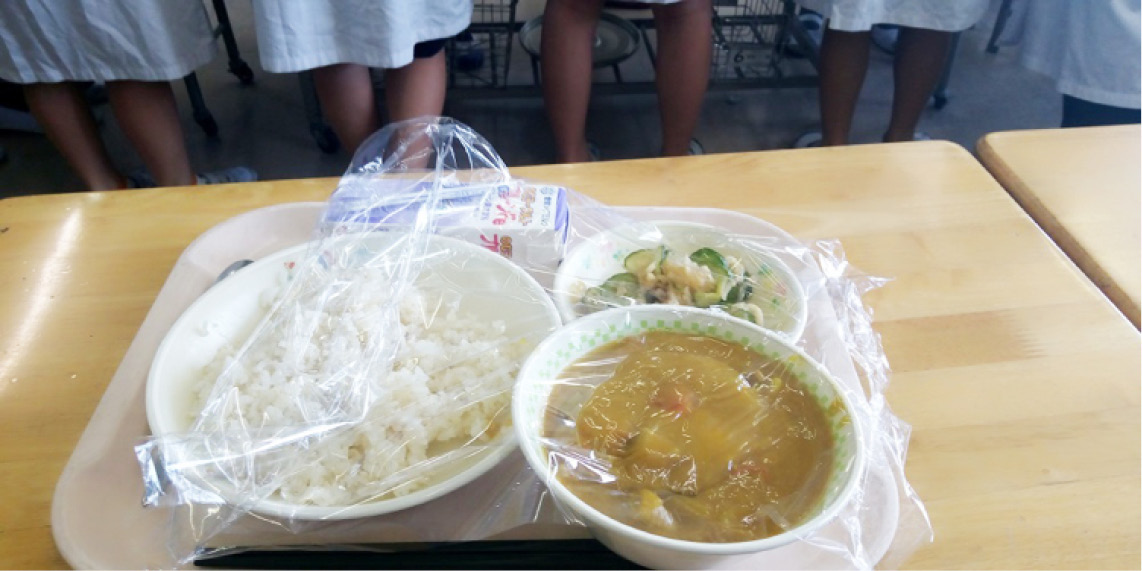Japan: Using school feeding programme to make better citizens
In Japan, school feeding programme is well structured, and it is turning young people into better citizens. Daily Trust on Sunday reports. In most restaurants and hotels in Japan, when customers or guests finish their meals, they gather plates, cutleries, disposables and other used items to a designated area for the workers to carry into […]

A typical lunch served in the school PHOTOS: Anthony Maliki
In Japan, school feeding programme is well structured, and it is turning young people into better citizens. Daily Trust on Sunday reports.
In most restaurants and hotels in Japan, when customers or guests finish their meals, they gather plates, cutleries, disposables and other used items to a designated area for the workers to carry into an inner section to wash. This is done without any fuse or bad feeling whatsoever.
People of all ages do this, except when a restaurant worker allows an elderly person not to do so as a mark of respect.
In many homes in African communities, it is not new for younger ones to remove plates after eating, but it rarely happens or does not happen in public eateries or restaurants.
It is a fact that workers are usually saddled with lots of work, with many customers heaping insults on them, and in some cases, look at them as inferiors. Here, the slogan that a “customer is always right” comes into play.
In Japan, it is seen as giving due respect and not saddling much work over something one can easily do.
This Japanese culture is what an enlightened society should be.

This is outlined to the pupils of Bairin Elementary School on a hilly part of the coastal city of Yokohama, through their school feeding programme.
From the outside, the three-storey 60-year-old grey school building looks like any normal learning institution, but activities in it typify the essence of the Japanese society.
Discipline, oneness, coordination, learning and neighbourliness are all stuffed in the minds of the teenagers.
Also, the building does not give any inclination into the positive issues imbibed into the kids. The playground is not classy too. However, when a group of journalists from six African countries visited the institution on July 10, 2019, they were amazed with the curricular of the pupils, especially the feeding programme. It is no surprise with the high level of advancement the Asian country has attained despite the devastation of the Second World War and with little natural resources. In fact, the capacity of its human resources is very high, and the elementary school seems to be the main focus.
The feeding programme for the 472-pupil-strong institution is worthy of emulation. The pupils participate in the preparation and cooking of the lunch.

On different days, they take turns in the kitchen with the cooks in the preparation, and each class is served in a large bowl, plates and cutleries. Their desks are used as dining tables as they form a circle in their classes. They are also served yogurt as dessert. In each class, pupils assisting in serving the meals wear aprons, toque blanche or white hat and nose masks for hygiene, as each pupil has a tray of food. It is so coordinated that no pupil has more or less food, and no one is expected to start eating until everybody is served. If one is not full, he or she is free to add from the remainder in the bowl at the middle of the class. The amazing thing is that no pupil ever fetches too much from the bowl, knowing that others may demand later too.
The more intriguing aspect of the programme is the evacuation of the plates and other items when the meal is over. Each pupil opens the empty yogurt pack and takes it to a table, separating it from the plates. Each item is placed accordingly – the plates, chop sticks, spoons and trays – on an improvised platform in the class. The food remnants are also put together, away from the hardware.
It was gathered that the yogurt pack are recycled into toilet papers or other relevant items. The packed items are then moved to the kitchen on the ground floor of the school.
There, another group of pupils help in washing the plates and packing them accordingly for next day’s use. Also, some other pupils mop the kitchen floor, keeping it dry and clean. One could see the excitement of the pupils doing all these chores and without being forced.

The school also boast of a music hall, with many instruments taught the pupils. There are also drama classes, as well as Japanese kanji writing to sustain the culture of the people.
The school also has a farm, where fruits are grown for the pupils, who are taught cultivation.
The school principal, Hideharu Kuroki, said the pupils were exposed to many educational subjects, vocations and expected societal attitudes to be better citizens.
The school, among others in Japan, is the bedrock of true character and learning the society is made of.
Clearly, doing things together, helping one another, making life better, and most importantly, respect for one another, are the true nature of the Japanese, right from the cradle.
